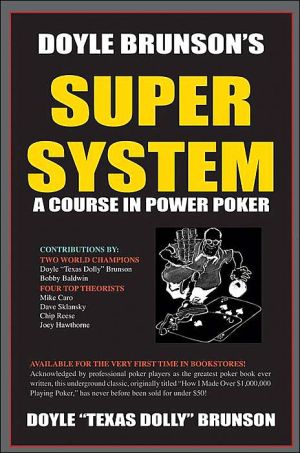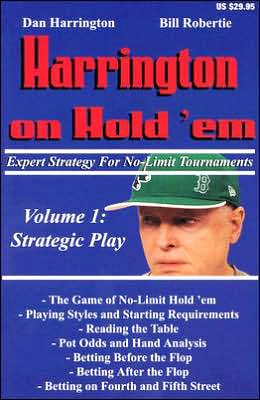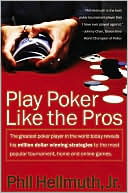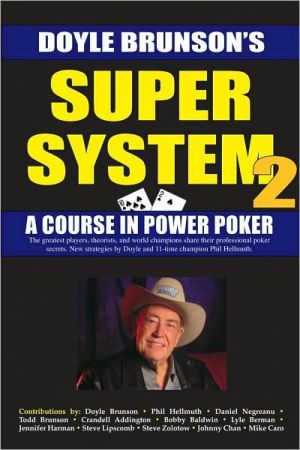Harrington on Cash Games: How to Win at No-Limit Hold'em Money Games, Volume 1
The first years of the poker boom were fueled by the interest in no-limit hold 'em tournaments. Recently, however, players have been gravitating to another, even more complex form of hold 'em - no-limit cash games. In Harrington on Cash Games: Volume I, Dan Harrington teaches you the key concepts that drive deep-stack cash game play. You'll learn how to tailor your selection of starting hands to your stack size, how to recognize the increasing deception value of supposedly "weaker" hands as...
Search in google:
The first years of the poker boom were fueled by the interest in no-limit hold em tournaments. Recently, however, players have been gravitating to another, even more complex form of hold em no-limit cash games. In Harrington on Cash Games: Volume I, Dan Harrington teaches you the key concepts that drive deep-stack cash game play. You'll learn how to tailor your selection of starting hands to your stack size, how to recognize the increasing deception value of supposedly weaker hands as the stack sizes increase, and how to use the concept of pot commitment to your advantage as the size of the pot grows. After laying out the general concepts behind deep-stack cash game play, Harrington shows you a complete strategy for post-flop play, and then teaches you the difference between post-flop play against a single opponent and post-flop play against multiple opponents. If you play no-limit hold em cash games, you need to read this book.
About Dan Harrington viiAbout Bill Robertie ixIntroduction 1Organization of the Books 1No-Limit Cash Games versus No-Limit Tournaments 3A Sample Hand 5Basic Ideas 17Introduction 18The Four Principles of Poker 19Expectation and Expected Value 22Example 23Pot Odds 27Example 28Expressed Odds and Implied Odds 30Example 30Calculating Outs 34The Rule of Four and The Rule of Two 37Bet Types 39The Value Bet 39The Probe Bet 40The Bluff 41The Semi-Bluff 41The Check 44Controlling Pot Odds 46Example 46The Elements of No-Limit Hold 'em Cash Games 49Introduction 50Stack Sizes 51Stack Sizes and Hand Selection 53Sample Hand No. 1 54Sample Hand No. 2 55Big Hand versus Big Hand 58Normalizing Hand Values 58Implied Odds Justification 60No-Limit Hold 'em and Venture Capitalists 61Hand Distribution as a Defensive Weapon 61Hand Selection in Tournament Play and Cash Play 62Stack Sizes and Bet Count Tables 64Stack Size, Pot Size, and Pot Commitment 67Idea No. 1: Balancing the Strength of Your Hand and the Size of the Pot 67Sample Hand No. 1 69Sample Hand No. 2 71Idea No. 2: Courting or Avoiding Pot Commitment 77Sample Hand 78Summarizing Hand Strength, Pot Size, and Pot Commitment 81Hand Reading 85Sample Hand 86Defending Against Hand Reading 92Diversifying Betting Sequences 93Sample Hand 95Recap: What Went Wrong? 100Deception 104Hand Analysis: Weighing the Evidence 105The Metagame 107Playing the Metagame 109When Not to Make Metagame Plays 115Metagame Evolution 116Avoiding Big Mistakes 117Hand Susceptibility 119Dealing with Short Stacks 121Tight-Aggressive Preflop Play 123Introduction 124Hand Evaluation and Stack Sizes 126Limping, Raising, and the Deception Principle 133Adopting Complementary Strategies 136Factoring in Your Post-Flop Skills 140Playing Individual Hands 141The Big Pairs 141Medium Pairs 143Small Pairs 145Small Pairs and Implied Odds 147Ace-King 148Ace-Queen 150Ace-Jack through Ace-Deuce 151The Trouble Hands 155Suited Connectors 156Other Playable Hands 158Playing the Small Blind 160Playing the Big Blind 162Attacking Limpers 168The Gap Concept in Deep-Stack Poker 169The Problems 171Tight-Aggressive Flop Play Heads-Up 217Introduction 218Your Goal in the Hand 223Bet Sizing on the Flop 224Raising the Initial Bet 226Sample Hand 228General Guidelines for Flop Play 230Handling a Single Pair on the Flop 234Betting Monsters on the Flop 239Example: Strategy No. 1 and Stacks of 100 Big Blinds 241An Interesting Variation: The All-In Semi-Bluff 246Various Flops and How to Respond 248Preflop Aggressor Out of Position 251You Raised with K[spades suit symbol]K[clubs] 252You Raised with A[heart suit symbol]Q[heart suit symbol] 256You Raised with T[clubs]T[spades suit symbol] 260Preflop Aggressor in Position 264You Raised with A[spades suit symbol]A[clubs] 265You Raised with A[heart suit symbol]Q[heart suit symbol] 272You Raised with 9[spades suit symbol]9[clubs] 278Non-Aggressor Out of Position 283You Called His Raise with J[heart suit symbol]J[diamond suit symbol] 283You Called His Raise with 3[clubs]3[heart suit symbol] 286You Called His Raise with K[clubs]J[spades suit symbol] 288You Called His Raise with 7[heart suit symbol]6[heart suit symbol] 290Non-Aggressor in Position 292You Called His Raise with T[heart suit symbol]T[clubs] 292You Called His Raise with 4[spades suit symbol]4[diamond suit symbol] 295You Called His Raise with K[spades suit symbol]Q[spades suit symbol] 297The Problems 300Tight-Aggressive Flop Play with Multiple Opponents 339Introduction 340Evaluating Hands in Multi-Way Pots 342Playing Very Strong Hands 344Sample Hand No. 1 346Sample Hand No. 2 347Sample Hand No. 3 349Playing Overpair and Top Pair Hands 353Sample Hand No. 1 354Sample Hand No. 2 355Playing Middle Pair and Low Pair Hands 357Sample Hand No. 1 357Sample Hand No. 2 359Sample Hand No. 3 360Playing Drawing Hands 364Sample Hand 365The Problems 370Index 413








